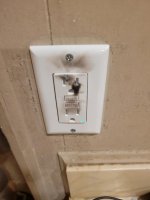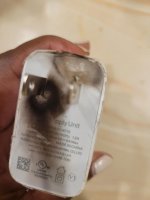GFCI's without AFCI function can also be argued as worthless: See Photo of new GFCI vs Defective Gadget
View attachment 2557784
GFCI Test & Reset button function normally after this event, which was completely undetected by the GFCI
View attachment 2557785
Neither heat or anything else tripped this bath GFCI in above photo, which smoked & burned between Hot-Neutral.
How AFCI's extinguish arcs is debatable, but they are observed in the field extinguishing smoldering and other non-arcing events.
AFCI breakers are known to trip together on same event, and when wiring lights are known to trip with Green & White wires held in opposite hands --at Zero amps-- with switch leg turned off.
AFCI are not superior to GFCI's, but do extinguish events GFCI's can not, since not limited to downstream-current imbalance.
To claim AFCI triggers are limited to arcs is Fake News.
To claim an AFCI trips on anything other than “arcing” is simply not true. During an arc you get a pulsed square-wave looking waveform. This highly nonlinear waveform is what the AFCI is looking for and what it trips on.
A combination AFCI is as it implies a combined GFCI and AFCI. And in this case I’d agree…it trips in arcing faults and ground faults. Perhaps you were confused or your statements were confusing due to your arrogance?
The inherent problem with this, is with SCR based rectifiers (active front ends) in electronics such as lamp dimmers and switching power supplies they switch on part way through the sine wave which gives it an arc-like waveform. This also causes AFCI trips but they are nuisance trips. Thus the incredibly bad reputation with AFCIs. The AFCI manufacturers have tried to discriminate but the fact is that it’s a balancing act between pinching pennies, false negatives, and false positives. The devices are highly tuned to ULs simulator but real world testing is not so good…see examples below.
Your pictures show a device that most likely underwent one of two failures. The first is overcurrent. There are many cases and reasons why overcurrent would be missed. For instance a 15 A breaker does not trip instantly at 15.000001 A. In fact it can trip at 75-300 A or higher in one cycle but under that current we are dealing with inverse time…the higher the current the faster it trips. A GFCI only device won’t care…current on hot and neutral is identical so no reason to trip. This example most likely shows a breaker failure or a utility fault. Overcurrent device only trips if current is pretty high.
It could also be damage due to a transient (voltage pulse) or even an arcing fault but it is well documented that line to line arcs are rare. Phase to neutral is the most common. An AFCI is programmed to trip on certain waveforms set by UL but not every arc looks like the UL test labs. In fact UL, NEC, and manufacturers have been soundly criticized for mandating AFCIs without any simple scientific explanation behind them.
Plus there are three kinds of arcing faults. In one type the arc is from phase to ground. Your claim that GFCI does nothing is utter nonsense because this is precisely the condition that GFCI is intended to detect and trip on. The second type is phase to neutral or phase to phase. Currents are balanced so GFCI should not trip while almost every AFCI can and does trip. But these are comparatively rare. A fourth type and likely what your device experienced are “series” arcs which is just a loose or open connection. Newer combination AFCIs are supposed to detect and trip on these but the only evidence is in the current signature which is notoriously hard to detect and subject to both false positives and negatives. Nobody will say that AFCIs work every time and nuisance tripping is a problem. But what happens in basic “redneck” YouTube style testing?
Here is a video with a combination AFCI:
A more fancy version, same result:
Ok but surely we can just look at house fires, right?
Yes there is lots of data showing a downward trend but there’s a huge problem with it. The downward trend correlates well with the introduction of GFCIs but the introduction of AFCIs which happened later does not show a change in slope. Thus the data touted by the AFCI manufacturers clearly demonstrates that GFCI protection alone is responsible for the improvements at best and that at worst some other external event is primarily responsible. This is one of the problems with looking at historical trends…correlation does not prove causation. However we can also look at different jurisdictions and compare the results (AFCI vs no AFCI) such as Virginia and North Carolina or Michigan and Indiana. These states have similar demographics. AFCIs were removed from Code in one but not the other. The result? Fire statistics are identical in both cases. This is a far stronger case for correlation than time based data but again no evidence that AFCIs do anything at all.
Here is what Michigan thinks of AFCIs:
The big claim for AFCIs is something called wood pyrolysis. The theory is that a staple driven through an NM to the point where it contacts the hot conductor will slowly char the wood via ground fault currents until it eventually arcs and starts a fire. I know this sounds like a joke but this is actually the mechanism claimed by the CPSC and used as justification for AFCIs. Obviously with wood which is a pretty good insulator there is not nearly enough energy for pyrolysis much less spark ignition but that’s actually the preposterous justification for AFCIs.
There’s more out there, a LOT more.
To accuse others of fake news claims when you don’t have a leg to stand on is right up there with most of the things Bob Acosta has to say. With the same level of arrogance and condescension.
Care to try again with actual scientific evidence?



